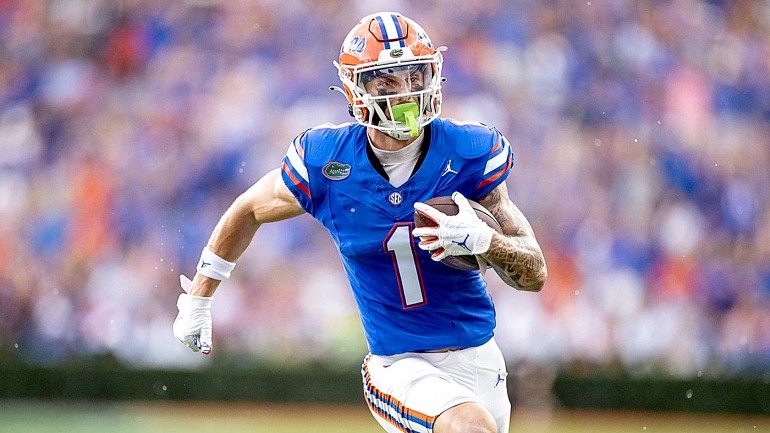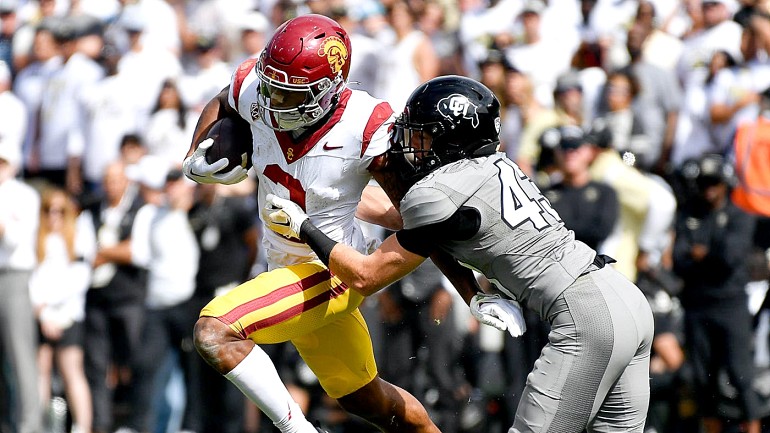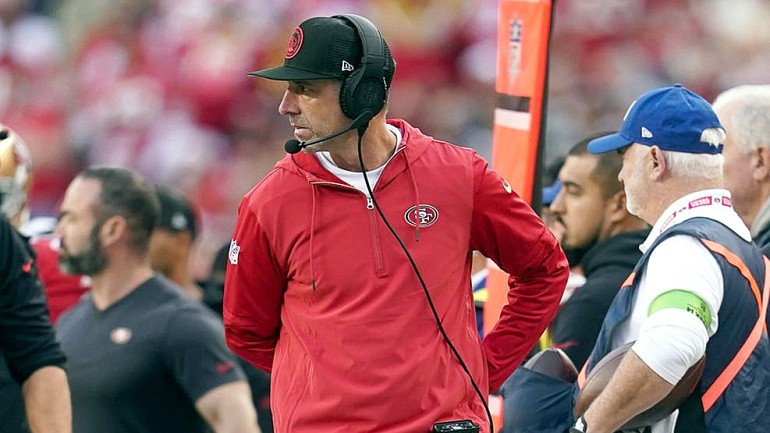Videos are auto-populated by an affiliate. This site has no control over the videos that appear above.
As always, every analyst has their pet theory for what signals future greatness in the NFL. One theory, debated every year, centers on what college a player attended. This makes sense because college football doesn't have the parity of the NFL. Teams in college play vastly different levels of competition and have huge gaps in the level of talent on their rosters. So scouts and fans can't just look at stats to see which players are ready to make the transition to Sundays.
One version of this theory goes like this: players in power conferences (the P5) play against the best of the best. Every week, they go to war against future NFL players. It follows then that these players have faced a level of physicality that makes them pro-ready. After all, if they've shined against such stiff competition, then they're ready for the big leagues.
But a second theory posits the reverse. This says that players from smaller schools, the "Group of Five" conferences, as well as other lower levels of college football (the G5), are better prepared for the pros. This theory argues that these players know what it's like to not be the biggest, strongest, or fastest person on the field. They've had to work hard to make it onto the NFL draft radar. As such, they're more likely to put in the work needed to succeed in the NFL when the time comes. On top of that, scouts and analysts underrate them because of the logo on their jerseys, meaning they fall further in the draft than they should.
But does a prospect's school really predict how he'll perform in the NFL, all else being equal? Of course, P5 players are better prepared for the NFL (most NFL players come from the P5). But if we take two players, drafted in similar spots, will their college tell us how likely they are to succeed?
Can the Niners find value by drafting players from smaller schools? One way to tell is to see if players from the G5 (and below) are more likely to make the Pro Bowl than their P5 counterparts. If they are, then that suggests that NFL teams might judge them more harshly, only drafting the true best of the best, and over-drafting players from bigger schools. And if that's true, then maybe the 49ers can gain a competitive edge by targeting players from smaller schools.
Unfortunately, the numbers put a damper on this idea. Among first-round picks, there is almost no difference in how often players from power conference schools make the Pro Bowl compared to those from non-power conference teams.
Since 2010, there have been 446 first-round picks. Forty have come from G5 (and smaller) schools, and 406 have come from P5 schools. Of the G5 players, 17/40 (42.5%) have made the Pro Bowl. Of the power-conference players, 160/406 (39.4%) have made the Pro Bowl.
The difference is negligible, especially given how small the sample size is for G5 players. In other words, NFL teams do not appear to be biased against G5 players, or biased in favor of P5 players, when deciding who is worthy of a first-round pick.
But digging deeper, the numbers tell an interesting story. From 2010-18, 29.4% of G5 players selected in the first three rounds made the Pro Bowl. For P5 players, that number was only 25.6%. But suddenly, the trend reversed. Since 2019, 14.4% of P5 selections have made the Pro Bowl. But in that same time span, only 4 out of the 83 G5 players have done the same—a mere 4.8%. Regardless of whether the NFL used to give G5 prospects less credit, these numbers, if anything, suggest that now NFL teams are overrating G5 players.
One reason for the sudden reversal might be TV exposure. Twenty or thirty years ago, G5 teams rarely made it on national television. Information was harder to compile, and teams had bigger gaps in how they evaluated prospects. Scouts may have really relied on more shortcuts and heuristics, including the logo on the prospect's college jersey.
But in recent years, the situation has changed. Every game is on national television, or at least a national streaming service like ESPN+. G5 prospects aren't hidden away in small media markets anymore. Their play is on display every Saturday, and their film is readily available.
Another reason might be the transfer portal. 2019 was around the time when transfers, both graduate and undergraduate, became much more common in college football. It might be that the best G5 players, and the ones most likely to get drafted, are now transferring "up" to P5 schools, making them P5 players for draft purposes. This means that the G5 prospects who heard their name called in the first three rounds ten years ago are now just P5 players.
This might explain the decline in G5 players making the Pro Bowl. If the best players are transferring to the P5, then we would expect the drafted players to be worse than they were ten years ago. If the best G5 players are transferring away, but NFL teams are selecting the same number of players from G5 programs, then they are likely selecting a less talented crop of players.
Making matters worse, recent years have seen a growing gap between the G5 and P5 in terms of talent and resources. Increasingly, P5 schools focus on one thing: amassing as much talent as possible. Gone are the days of schools competing for national titles with only local recruits or "our kinda guys." P5 schools are about one thing and one thing only: acquiring as much talent as possible. Combined with the disparity in financial resources and facilities between G5 and P5, the talent gap has never been bigger.
Lastly, the players who don't transfer might be sending a signal about their talent or work ethic. Just because a player wants to transfer doesn't mean a school will take him. Often, players who don't transfer from the G5 are still exploring their options. But often they fail to transfer because larger programs don't see them as talented enough to make an impact. They also might fail because larger programs have doubts about their work ethic or commitment to football.
Why wouldn't the NFL recognize this trend and adjust accordingly? There might be a few reasons. First, it might just be that NFL haven't yet realized just how big the exodus of talent from G5 schools is. Because so many good players leave via the transfer portal, the overall competition level may be much lower than before. This allows less talented players to shine and raise their draft stock. But scouts may not have fully grasped just how barren the talent cupboard is at the G5 level. Second, NFL scouts might not know why a G5 player couldn't transfer to a P5 school, and so might not have enough information about their shortcomings.




